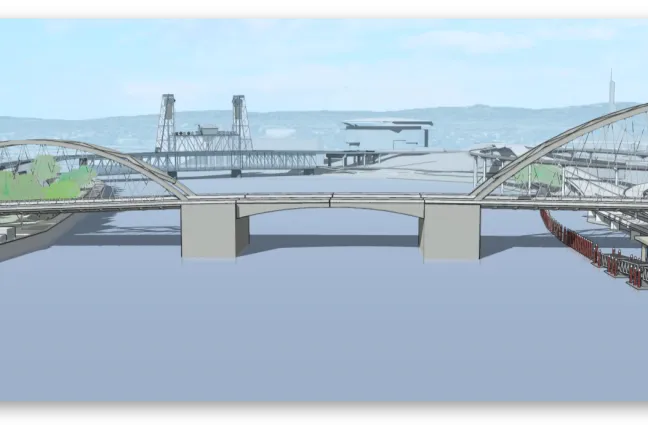A new earthquake-ready Burnside Bridge will require a taller structure than the existing bridge, project team members told Multnomah County commissioners at a January 12 briefing. The presentation covered structure types that are being considered for a new Long Span bridge, and a preview of the project’s draft Environmental Impact Statement that will be released for public comment in early February.
The new bridge will need to be taller than the current bridge because it will have longer spans with fewer support columns, explained Mike Pullen, with the county’s Communications Office. Fewer support columns will reduce the risk of unstable soil near the river liquifying during a major earthquake and damaging the bridge.
Because the area of unstable soil is much wider on the east side of the river, the east approach span will need to be longer than the west approach, with a taller support structure above the deck. Commissioner Sharon Meieran noted that having differences between the east and west sides of the bridge is not a negative. “I see there will be some asymmetry. Personally I love that,” she said.
Pullen explained that the east approach span will be more than 600 feet long, stretching from near 2nd Ave. to the east river pier. The structure types being considered for the east approach include a tied-arch (like the Fremont Bridge), a cable supported bridge (like the Tilikum Crossing) and a truss bridge (like the Hawthorne Bridge).
The west approach span will be about 400 feet long. All of the bridge types being considered for the east approach also work for the west approach. On the west side the structures above the deck could be shorter than on the east approach, due to the shorter span length. The west approach could also be a girder span, with no structure above the deck but less space below the bridge, due to the thicker structure needed.
Pullen said that a volunteer on one of the project’s committees said it is appropriate that the west approach not be as tall as the east approach, due to the lower building height limit in the historic district surrounding the west bridgehead.
There are only two options being considered for the movable drawbridge. It could be a bascule drawbridge similar to the current Burnside Bridge, or a vertical lift drawbridge, such as the Hawthorne Bridge. A bascule bridge would provide more open views for bridge users while a lift bridge would require towers that would limit views from the bridge. A lift bridge could have smaller river piers and would not take as long to open and close for ships.
Starting January 22, the county will be gathering public comments on the range of bridge types recommended by the project’s Community Task Force. There will be a three-week online survey to gather input. Several of the county’s commissioners said they looked forward to sharing their preferences during the online survey. The survey results will be considered by the Community Task Force which will recommend a bridge type in late spring 2021.
Project Manager Megan Neill said that the project’s draft Environmental Impact Statement (DEIS) will be released for public comment in early February, after it is approved by the Federal Highway Administration. A DEIS compares the impacts of a range of alternatives and is required for projects that need federal permits to be built. The public will have 45 days to review and comment on the DEIS after it is published, Neill explained. The project will release an executive summary of the DEIS and one-page summaries of all its technical supports to make it easy for the public to understand.
In addition to required DEIS study topics such as impacts to transportation and land use, Neill explained that the project also evaluated topics that reflect Multnomah County’s values, such as climate change, equity and public health.
“I’m glad we are doing a deeper dive on those additional topics,” said Commissioner Lori Stegmann, “as well as the short and long-term costs of the project.”
Neill explained that the project team will prepare a final EIS this fall which needs to be approved by the Federal Highway Administration before design work can begin in 2022. Construction could start as soon as 2024, if funds can be secured.
After viewing all of the images of what a new downtown bridge could look like, Commissioner Jessica Vega Pederson predicted that this “will spark engagement with the public much more since we’re talking about what the bridge will actually look like.”
Commissioner Susheela Jayapal was impressed by the project’s work to reach out to cultural groups that do not speak English as a first language. “I really appreciate the reach and depth of the community engagement work that we’re doing,” she said.
County Chair Deborah Kafoury noted that while the project will be costly, she is hopeful the federal government will contribute funding. “I was on a conference call with incoming transportation secretary Pete Buttigieg last week to learn about the new administration’s infrastructure priorities,” she said. “I was heartened to learn that their focus will be on equity, the environment, jobs and safety. Our project checks off on all of those priorities too.”
For project information, visit www.burnsidebridge.org.


